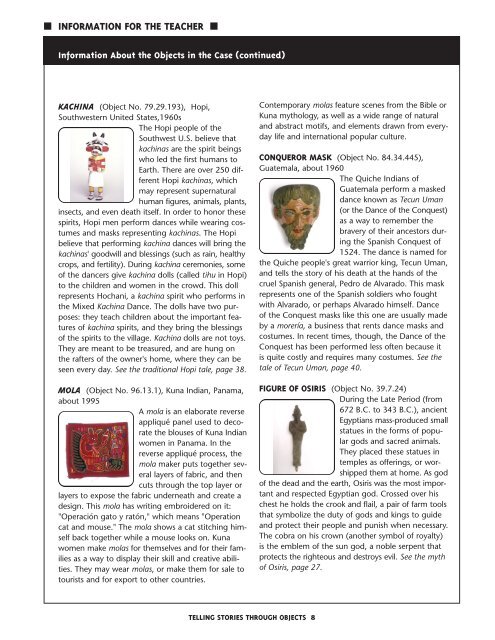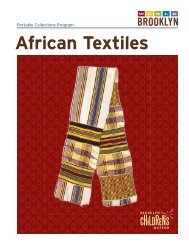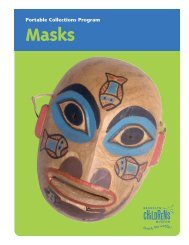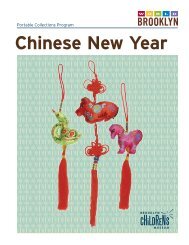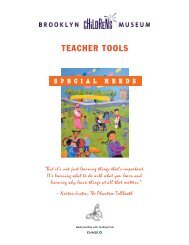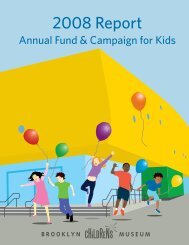Telling Stories Through Objects - Brooklyn Children's Museum
Telling Stories Through Objects - Brooklyn Children's Museum
Telling Stories Through Objects - Brooklyn Children's Museum
Create successful ePaper yourself
Turn your PDF publications into a flip-book with our unique Google optimized e-Paper software.
■ INFORMATION FOR THE TEACHER ■<br />
Information About the <strong>Objects</strong> in the Case (continued)<br />
KACHINA (Object No. 79.29.193), Hopi,<br />
Southwestern United States,1960s<br />
The Hopi people of the<br />
Southwest U.S. believe that<br />
kachinas are the spirit beings<br />
who led the first humans to<br />
Earth. There are over 250 different<br />
Hopi kachinas, which<br />
may represent supernatural<br />
human figures, animals, plants,<br />
insects, and even death itself. In order to honor these<br />
spirits, Hopi men perform dances while wearing costumes<br />
and masks representing kachinas. The Hopi<br />
believe that performing kachina dances will bring the<br />
kachinas' goodwill and blessings (such as rain, healthy<br />
crops, and fertility). During kachina ceremonies, some<br />
of the dancers give kachina dolls (called tihu in Hopi)<br />
to the children and women in the crowd. This doll<br />
represents Hochani, a kachina spirit who performs in<br />
the Mixed Kachina Dance. The dolls have two purposes:<br />
they teach children about the important features<br />
of kachina spirits, and they bring the blessings<br />
of the spirits to the village. Kachina dolls are not toys.<br />
They are meant to be treasured, and are hung on<br />
the rafters of the owner's home, where they can be<br />
seen every day. See the traditional Hopi tale, page 38.<br />
MOLA (Object No. 96.13.1), Kuna Indian, Panama,<br />
about 1995<br />
A mola is an elaborate reverse<br />
appliqué panel used to decorate<br />
the blouses of Kuna Indian<br />
women in Panama. In the<br />
reverse appliqué process, the<br />
mola maker puts together several<br />
layers of fabric, and then<br />
cuts through the top layer or<br />
layers to expose the fabric underneath and create a<br />
design. This mola has writing embroidered on it:<br />
"Operación gato y ratón," which means "Operation<br />
cat and mouse." The mola shows a cat stitching himself<br />
back together while a mouse looks on. Kuna<br />
women make molas for themselves and for their families<br />
as a way to display their skill and creative abilities.<br />
They may wear molas, or make them for sale to<br />
tourists and for export to other countries.<br />
TELLING STORIES THROUGH OBJECTS 8<br />
Contemporary molas feature scenes from the Bible or<br />
Kuna mythology, as well as a wide range of natural<br />
and abstract motifs, and elements drawn from everyday<br />
life and international popular culture.<br />
CONQUEROR MASK (Object No. 84.34.445),<br />
Guatemala, about 1960<br />
The Quiche Indians of<br />
Guatemala perform a masked<br />
dance known as Tecun Uman<br />
(or the Dance of the Conquest)<br />
as a way to remember the<br />
bravery of their ancestors during<br />
the Spanish Conquest of<br />
1524. The dance is named for<br />
the Quiche people's great warrior king, Tecun Uman,<br />
and tells the story of his death at the hands of the<br />
cruel Spanish general, Pedro de Alvarado. This mask<br />
represents one of the Spanish soldiers who fought<br />
with Alvarado, or perhaps Alvarado himself. Dance<br />
of the Conquest masks like this one are usually made<br />
by a morería, a business that rents dance masks and<br />
costumes. In recent times, though, the Dance of the<br />
Conquest has been performed less often because it<br />
is quite costly and requires many costumes. See the<br />
tale of Tecun Uman, page 40.<br />
FIGURE OF OSIRIS (Object No. 39.7.24)<br />
During the Late Period (from<br />
672 B.C. to 343 B.C.), ancient<br />
Egyptians mass-produced small<br />
statues in the forms of popular<br />
gods and sacred animals.<br />
They placed these statues in<br />
temples as offerings, or worshipped<br />
them at home. As god<br />
of the dead and the earth, Osiris was the most important<br />
and respected Egyptian god. Crossed over his<br />
chest he holds the crook and flail, a pair of farm tools<br />
that symbolize the duty of gods and kings to guide<br />
and protect their people and punish when necessary.<br />
The cobra on his crown (another symbol of royalty)<br />
is the emblem of the sun god, a noble serpent that<br />
protects the righteous and destroys evil. See the myth<br />
of Osiris, page 27.


